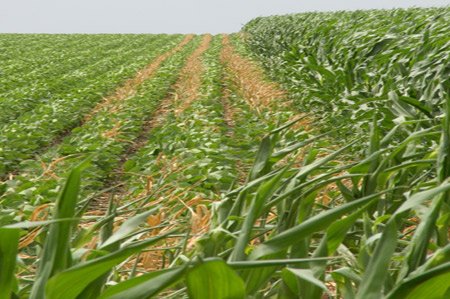 (AgProfessional) – As of May 5, an estimated 12 percent of this year’s corn crop had been planted, at a point in the season when the share of the crop planted is typically near 50 percent. Planting progress is below the 5-year average in all of the 18 states reported in the weekly Crop Progress report, but progress is close to average in Pennsylvania and North Carolina. The very slow pace of planting has everyone wondering if acreage will actually reach the 97+ million acres farmers said they would plant and if yield potential is being adversely affected.
(AgProfessional) – As of May 5, an estimated 12 percent of this year’s corn crop had been planted, at a point in the season when the share of the crop planted is typically near 50 percent. Planting progress is below the 5-year average in all of the 18 states reported in the weekly Crop Progress report, but progress is close to average in Pennsylvania and North Carolina. The very slow pace of planting has everyone wondering if acreage will actually reach the 97+ million acres farmers said they would plant and if yield potential is being adversely affected.
In this article we look at past years to get some idea of farmers’ ability to catch up on corn planting if the weather improves. Weather forecasts indicate a dry period over much of the Midwest this weekend and early next week. But farmers have a lot of catching up to do and even with the bigger planting equipment, there is no real doubt that some of the crop will be planted after the optimum period is over. Since corn farmers intended to plant more than 97 million acres this year, the progress this year implies about 12 million acres had been planted as of last Sunday versus about 42 million acres at this point during the last five years.
The slow pace of planting progress this year is unprecedented, at least based on data for the last 29 years. The previous low for this point in the year is 9 percent planted back in 1984. In 2008 and 2011, recent years with slow planting progress in early May, the share planted stood at 30 percent and 28 percent, respectively. Despite the delayed early planting, actual acreage came in very close to intentions in both of those years. In fact, the biggest negative deviation from intentions in the last 18 years came in 1995 (4 million acres). As discussed in last week’s AgInsight, corn production would still be near 14 billion bushels with 93 million acres planted and a trend yield of 163 bushels per acre.
The end of the optimum planting period varies by state and region, but corn planted after May 20 would be considered late in most of the country. However, the end of the optimum planting period does not mean that producers stop planting corn. Farmers were still planting corn in the first week of June in 2008, 2009 and 2011. In those three years 25 percent to 30 percent of the crop was still to be planted after May 20th.
How fast can farmers plant corn if the weather improves? There are reports of farmers in some states planting as much as half their acreage in a single week, but there are no examples of that happening on a national level. The largest week-to-week change in the share of the crop planted was 37 points back in the first week in May of 1992. Even with the spread of larger planting equipment, the largest week-to-week change in the last 5 years is 25 percentage points. This happened the first week in May in 2011. The largest week-to-week change for this second week in May was 21 points in 2008.
So, we will assume that weekly planting progress through the next three weeks of May matches the previous high for that particular week during the last 20 years. In this case the highest weekly totals for the three weeks to the end of May, including the current week, all occurred in 1993, the year of the big flood. The highs for the next three weeks are 26 percentage points for this week, 25 percentage points for next week and 12 percent for the week ending May 26. Add that to the 12 points planted as of last Sunday and add another 5 points for the period from May 26 to May 31 and 80 percent of the corn crop would be planted as we head into June. This scenario assumes aggressive planting progress well above the 5-year average levels for those weeks of 14 percent, 10 percent and 5 percent, respectively. Even so that would still leave us with about 19 million acres of corn to plant in June. That compares to about 9 million acres remaining to be planted in June 2011.
Good weather over the summer months can offset the effects of late planting on yields, but can’t offset the effects of the land not getting planted at all. The data so far suggests that acreage will drop below the 97.2 million acres farmers said they would plant back in March. The magnitude of the decline will depend on weather conditions over the next 4 weeks or so, but a reduction of 3 million acres or more seems likely. That reduction in planted acreage makes summer weather and actual yields very important to corn carryover supplies and prices.




